The first roads were created by migrating animals. They hammered down paths through terrain that was easy to follow by human hunter-gatherers. By the time the weather stabilized at the end of the last Ice Age, roads connecting the beginning of agricultural settlements existed in regions with human habitation. What are eight incredible facts about the oldest roads in the world? Read on to find out.
1. Toll Roads Are Over 2,000 Years Old
An ancient Sanskrit treatise from India called the Arthashastra is one of the first written references to toll roads. Toll roads are roads created and maintained by a governing entity that cost money to use. There are toll roads and toll bridges in the United States and elsewhere today.
The Arthashastra is believed to be around 2,300 years old. Tolls to use constructed roads were acknowledged alongside other forms of taxation used to generate revenue for the king.
2. The Sumerians Were the First to Use Asphalt
Bitumen is the primary component of today’s asphalt and it was used by the Sumerians to lock huge bricks into place. While it wasn’t initially used to pave roads, asphalt in road construction was in use by later cultures in 625 BCE.
The Ancient Greeks used asphalt in a variety of applications from roadways to mummification. The word asphalt derives from the Greek word “asphaltos.” This means “secure.”
3. Warding Off Evil Spirits with Road Turns in Ancient China
In China, evil spirits only travel in straight lines so roads sometimes turned when approaching a city or important space. Without this, roads were dangerous corridors for spirits. This tradition also made its way to Japan and influenced the Masugata gate design on old castles.
Usually, the Japanese tradition dictated that a 90-degree turn needed to be made upon approach. In unrelated traditions, ideas around crossroads at 90-degree road intersections also redirected spirits in medieval Europe and beyond.
4. Modern Car Width Standardization Originates with Ancient Roman Roads
In 450 BCE, the first legal code in Rome designated how wide different street types should be. For all wheeled carts that rolled through these streets, standards were placed on how wide any cart or chariot could be. This allowed for ease of traffic flow.
Millenia later, this practice is still in use. While today’s exact car size isn’t the same as the Roman standard, it isn’t far off.
5. Mixing Along Roads Created New Art and Culture
Cultural intermingling took place along trade routes. An example is an art style created by the intermingling of ancient cultures on the oldest trade routes called Greco-Buddhism.
It is a result of the importation of Greek culture into the Gandhara region. The Gandhara region historically was the northwest Indian subcontinent with parts in present-day Pakistan and Afghanistan. This particular cultural intersection dates from the third to fifth centuries CE.
It shows Buddhist themes in Hellenistic art styles. This mixture probably led to the birth of physical representations of Gautama Buddha for the first time.
6. Modern Highways Sometimes Follow Ancient Roads
In some places, animal trails led to humans using those trails. These trails were developed over time as technology improved or they fell into disuse and were reclaimed by nature.
There are portions of major highways that still follow ancient paths. While the original dirt or pavement is usually covered, the general route sometimes remains the same for thousands of years. That’s because these routes are still the best way of traveling between two defined places.
Via Flaminia in Italy
The Via Flaminia is named after the Roman emperor named Flaminius. It was built sometime around 220 BCE. While its most ancient history is unknown, it was a well-established path between Rimini and Rome that existed well before recorded history.
Some of the modern SS3 north of Rome in Italy traverses the same general path as the ancient Via Flaminia. There are also spots along the modern route where remains of the Roman road run parallel to the current thoroughfare.
Fosse Way in Britain
The original Fosse Way was built by the Ancient Romans when they invaded Britain almost 2,000 years ago. Part of the original Fosse Way exists as the A46 between Leicester and Lincoln in the East Midlands.
Some parts of what isn’t part of modern main roads are still used as paved and unpaved farm roads. Ditches used for defense built by the Romans along their ancient frontier were referred to as fossa which inspired the name it has today.

The Fosse Way was built by ancient Romans when they invade Britain. It’s still used today and is one of the oldest roads in the world.
I-90 in Washington State
A portion of I-90 follows a route through the Cascade Mountains in Washington initially used by Native Americans for thousands of years. This area, known as Snoqualmie Pass, is one of the busiest mountain corridors in the United States.
The entire interstate runs from Seattle, WA to Boston, MA. Snoqualmie Pass is located just east of Seattle. In the United States, an interstate is part of a nationwide system of highways that allow almost uninterrupted travel between states.
7. The Phrase “I’m Stumped” and Colonial American Roads
While roads existed in America when Colonialists arrived, they didn’t accommodate wheeled wagons. As a result, co-opted routes were widened as settlers fanned out across the continents. As this process took place, roads were often in terrible conditions.
The roads that had existed in the Americas usually accommodated single-file humans as pack animals and wheeled transportation wasn’t a part of indigenous life. Europeans began widening roads but it involved clearing old-growth wilderness.
This left lots of stumps in the road. It was so common for travelers to get hemmed up over something in the road catching a wheel that “I’m stumped” became a colloquialism still used today.
8. The Term Highway Is From Ancient Rome
Some Ancient Roman roads were built for their military importance. They allowed for the swift trade of goods and expedient message delivery in clear-cut directions toward defined cities.
Because they were heavily used to move troops and weaponry, they were also elevated. This elevation allowed the Romans to have an unobstructed view from every angle which reduced the threat of ambush or mass organized strikes. Today, the word highway is still used to describe a well-used thoroughfare.
Up Next:
- The 10 Best Books About Roman Mythology
- Different Ancient Flags That Have Been Lost to History
- The 6 Oldest Countries in Europe
The photo featured at the top of this post is © Indiana jo, CC BY-SA 4.0, via Wikimedia Commons – License / Original
Thank you for reading! Have some feedback for us? Contact the AZ Animals editorial team.







